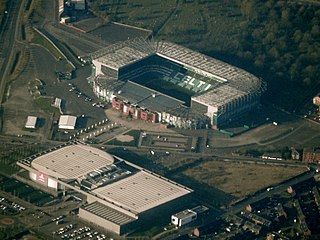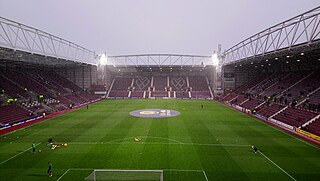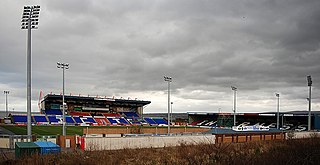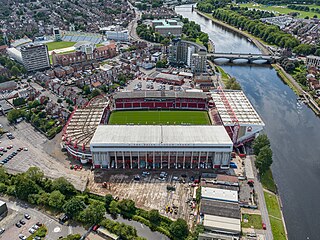
Aberdeen Football Club is a Scottish professional football club based in Aberdeen, Scotland. They compete in the Scottish Premiership and have never been relegated from the top division of the Scottish football league system since they were elected to the top flight in 1905. Aberdeen have won four Scottish league titles, seven Scottish Cups and six Scottish League Cups. They are also the only Scottish team to have won two European trophies, having won the European Cup Winners' Cup and the European Super Cup in 1983.

Celtic Park is a football stadium, currently the home of Scottish Premiership team Celtic Football Club, in the Parkhead area of Glasgow, Scotland. With a capacity of 60,832, it is the largest football stadium in Scotland, and the eighth-largest stadium in the United Kingdom. It is also known as Parkhead or Paradise.

Inverness Caledonian Thistle Football Club, commonly known as Caley Thistle, Inverness CT or just Inverness, is a professional football club based in Inverness, Scotland. The team currently competes in the Scottish Championship, the second tier of the Scottish Professional Football League, and hosts home games at Caledonian Stadium.

Tannadice Park, usually referred to as Tannadice, is a football stadium in Dundee, Scotland. It is the home ground of Dundee United F.C., who have played at Tannadice since the club was founded as Dundee Hibernian in 1909. The stadium has been all-seated since 1994 and has a capacity of 14,223. It is located only 200 yards from Dundee F.C.'s stadium, Dens Park; the two are the closest senior football grounds in the UK.

Tynecastle Park, also known as Tynecastle Stadium, is a football stadium in the Gorgie area of Edinburgh, which is the home ground of Scottish Professional Football League club Heart of Midlothian (Hearts). A UEFA category four stadium, it has also hosted Scotland international matches, and been used as a neutral venue for Scottish Cup and Scottish League Cup semi-finals.

Caledonian Stadium is a football ground in the Longman area of Inverness, Scotland, near the banks of the Moray Firth. It hosts home matches of Scottish Professional Football League club Inverness Caledonian Thistle.

The City Ground is a football stadium in West Bridgford, Nottinghamshire, England, on the banks of the River Trent. It has been home to Nottingham Forest F.C. since 1898 and has a capacity of 30,455.

Glanford Park is a football stadium in Scunthorpe, Lincolnshire, England, and is the home of National League North team Scunthorpe United.
Duncan Nichol Shearer is a Scottish former footballer, currently coaching the 'Development squad' at Inverness Caledonian Thistle. During his playing career, Shearer predominantly played for Huddersfield Town, Swindon Town, Aberdeen and Inverness. He also captained the Scotland 'B' team and played seven times for the full Scotland national team.

Darren Graham Mackie is a Scottish former footballer who, most recently, played for Inverurie Loco Works as a player/coach. Mackie was born in Inverurie, Aberdeenshire, Scotland and previously played as a striker for Aberdeen in the Scottish Premier League between 1998 and 2012, with a loan spell at Inverness Caledonian Thistle in 2004.

Kynoch Park is a football ground in Keith in north-east Scotland, which is the home ground of Highland Football League side Keith F.C. It is located on Balloch Road in the east of the town and has a capacity of 2,362 with 370 seated.
The 2004–05 Scottish Premier League was won by Rangers, who claimed the title on the final day of the season by a single point from Celtic, who had gone into the final fixtures leading and were still ahead in the closing minutes of their last game against Motherwell until they conceded two goals, costing them the title with Rangers winning their match against Hibernian in Edinburgh. The dramatic events became known in popular culture as 'Helicopter Sunday' due to the aircraft ceremonially delivering the championship trophy changing direction in mid-flight as the identity of its winners altered suddenly.

Links Park is a football stadium in Montrose, Scotland. It has been the home ground of Montrose F.C. since 1887.
The 2000 Scottish Cup Final was the final match of the 1999–2000 Scottish Cup. It was played on 27 May 2000 at Hampden Park in Glasgow, Scotland, and was the final of the 115th Scottish Cup. The final was contested by Scottish Premier League clubs Aberdeen and Rangers. Rangers won the match 4–0. The match was the last in the career of Aberdeen goalkeeper Jim Leighton. He was injured after two minutes and was unable to play on. With no goalkeeper on the substitutes bench, striker Robbie Winters played in goal for Aberdeen.
The term North derby is sometimes used to emphasise their relative geographical proximity, when matches are played between Scottish football clubs Aberdeen and Inverness Caledonian Thistle. The clubs first met in a Scottish League Cup tie played on 8 August 1998. Inverness first entered the Scottish Football League in 1994 alongside fellow Highland side Ross County, forming the Highland derby. However, Inverness progressed over the next 10 years to form a rivalry with Aberdeen, after winning promotion to the Scottish Premier League in 2004.

Telford Street Park was a football ground in Inverness, Scotland. It was the home ground of Caledonian F.C. and latterly Caledonian Thistle F.C.
Inverness Caledonian Thistle F.C. in their tenth season in the Scottish Football League competed in the Scottish First Division, Scottish League Cup, Scottish Challenge Cup and the Scottish Cup in season 2003–04. They won their first major trophy when they won the Challenge Cup beating Airdrie United in the final 2–0 with goals from Steve Hislop and David Bingham, and at the end of the season, they won the First Division Championship, securing promotion to the Scottish Premier League. However, SPL rules at that time stated that all member clubs must have a stadium with a minimum capacity of 10,000 seats. Caledonian Stadium did not and this left the club's board with a dilemma: either to stay in the First Division like Falkirk the previous season or to groundshare with Aberdeen's Pittodrie Stadium, over 100 miles (160 km) away. After consulting with supporters, the board decided the sacrifice of one season in Aberdeen would be worthwhile for Premier League football.
Over the 150-year history of football in Scotland, most teams have occupied several grounds as their home; this has occasionally involved a relocation to another community altogether. Grounds which have been in continuous use for several decades have been extensively redeveloped, particularly since the 1990s, with a few exceptions. This article and the accompanying tables focus on those Scottish Football League / Scottish Professional Football League clubs which have moved to a different stadium, including temporarily, since the 1980s when this became more frequent.






















